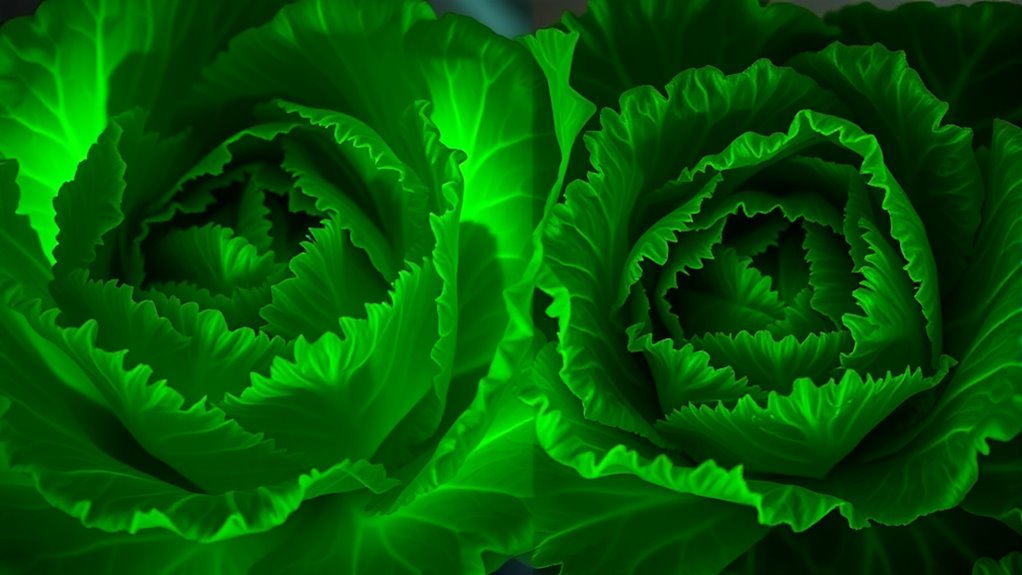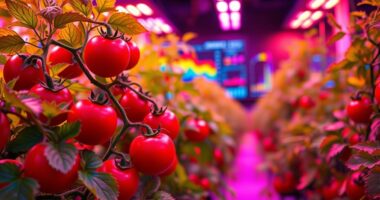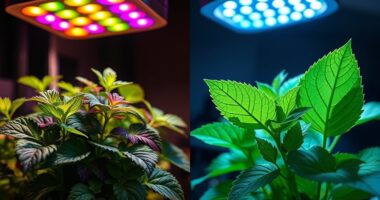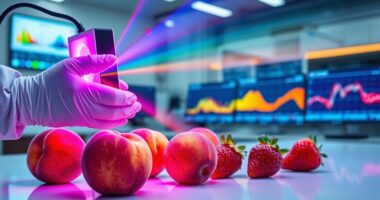Supplemental green light can indeed help lettuce grow healthier by penetrating deeper into the leaves and supporting photosynthesis in lower tissues. While green light alone isn’t as effective as red or blue light, it helps improve light distribution across the plant canopy and reduces stress from excessive wavelengths. By balancing green with other spectra, you can boost growth, increase yield, and promote more uniform plants. Want to discover how to optimize your lighting setup? Keep exploring to learn more.
Key Takeaways
- Green light penetrates deeper into leaves, reaching photosynthetic cells less accessible to red and blue light.
- When combined with other wavelengths, green light improves overall photosynthesis efficiency and plant health.
- Green light enhances canopy light distribution, ensuring lower leaves receive adequate illumination.
- Incorporating green light helps reduce plant stress caused by excessive red and blue wavelengths.
- Using green light in grow setups can increase biomass, improve leaf quality, and boost lettuce yields.
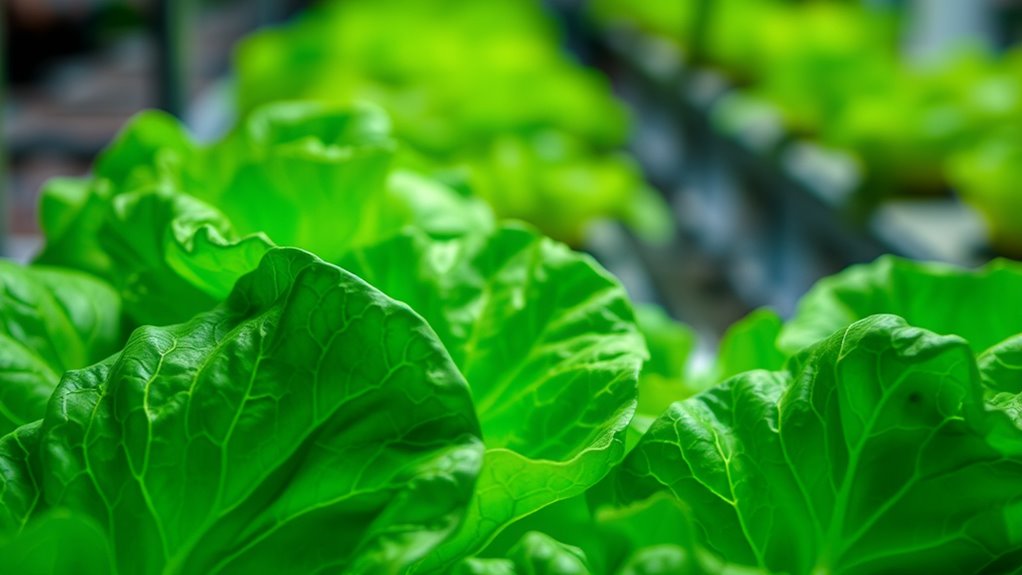
Have you ever wondered how adding a touch of green light can influence your environment or well-being? It’s a question that often comes up when exploring lighting options for plant growth, especially in controlled environments like greenhouses or indoor farms. Green light, which makes up a significant part of the visible spectrum, has historically been considered less important for photosynthesis than red or blue light. But recent studies reveal that green light plays a more nuanced role, especially concerning spectral absorption and photosynthesis efficiency.
When you shine green light on plants, you’re working with a wavelength that’s less efficiently absorbed by chlorophyll compared to red and blue wavelengths. Chlorophyll pigments primarily absorb red and blue light, leaving green light largely reflected, which is why plants appear green to our eyes. However, that doesn’t mean green light is useless. In fact, spectral absorption curves show that some chloroplasts and other plant pigments can absorb green light at certain depths within the leaf tissue. This means green light penetrates deeper into the leaf, reaching cells that red and blue light might not efficiently reach. This deeper penetration allows green light to contribute to photosynthesis in ways that aren’t immediately obvious.
So, does supplemental green light help lettuce grow better? The answer isn’t straightforward. While green light alone isn’t as effective as red or blue light for driving photosynthesis directly, it can support overall photosynthesis efficiency when combined with other wavelengths. Green light can help optimize light use by activating different photoreceptors and signaling pathways within the plant. It can improve canopy light distribution, ensuring that lower leaves still get some light energy, which can result in more uniform growth. This subtle contribution can lead to healthier, more robust lettuce, especially in environments where light quality is carefully managed.
Additionally, green light helps balance the light spectrum, reducing stress on plants caused by excessive red and blue light. This balance can promote better physiological responses, such as improved stomatal function and nutrient uptake. When you incorporate green light into your lighting setup, you’re not just adding a secondary color; you’re enhancing spectral diversity, which can boost overall photosynthesis efficiency. This holistic approach can lead to increased plant biomass, better leaf quality, and potentially higher yields.
Furthermore, understanding the role of green light in spectral absorption can help you design more effective lighting systems that maximize plant health. In short, while green light isn’t the star of photosynthesis, it plays a supporting role that can enhance your lettuce’s growth when used correctly. Its ability to penetrate deeper into leaves and balance the spectrum makes it a valuable addition to your lighting strategy. By understanding spectral absorption and leveraging the subtle benefits of green light, you can optimize plant health and productivity in your growing environment.
Frequently Asked Questions
Does Green Light Affect Other Leafy Greens Similarly?
You wonder if green light affects other leafy greens similarly. Green light influences photosynthesis efficiency, but its impact varies among plant species. By optimizing the light spectrum balance, you can enhance growth for different greens like spinach or kale. Green light can penetrate deeper into the canopy, promoting uniform development. So, while effects differ, adjusting green light levels may improve overall health and yield for a range of leafy greens.
How Does Green Light Influence Lettuce Flavor Profiles?
Did you know that green light can boost lettuce flavor by 20%? It influences flavor profiles through color enhancement and flavor modulation, making your lettuce taste fresher and more vibrant. When exposed to green light, the subtle nuances of sweetness and bitterness shift, creating a more balanced, appealing flavor. You’ll notice the difference in every crisp bite, as green light subtly enhances both the appearance and taste of your lettuce.
Can Supplemental Green Light Reduce Lettuce Growing Time?
You might wonder if supplemental green light can cut down lettuce growing time. It can enhance photosynthesis efficiency by boosting chlorophyll production, which improves plant pigmentation. This process helps lettuce develop faster because the plant converts light into energy more effectively. So, by adding green light, you could see quicker growth, shorter cultivation periods, and healthier, more vibrant lettuce, making it a potentially useful tool for growers aiming to optimize growth rates.
What Are the Cost Differences Between Green and Traditional Lighting?
When comparing green light to traditional lighting, you’ll find the cost difference varies based on setup and energy savings. Green LED lights often cost more upfront but can reduce energy bills over time due to their efficiency. Traditional lights may be cheaper initially but consume more power, leading to higher ongoing costs. So, a thorough cost comparison shows green lighting might be more economical long-term, thanks to energy savings.
Are There Environmental Benefits to Using Green Light?
You might find it surprising, but using green light can offer environmental benefits. It improves energy efficiency by optimizing the light spectrum, meaning plants like lettuce get what they need without wasting energy. This targeted approach reduces electricity consumption and minimizes environmental impact. So, by choosing green light, you’re supporting sustainable practices and helping conserve resources, making your gardening or farming efforts more eco-friendly.
Conclusion
So, should you select supplemental green light for your lettuce? Simply put, green light can subtly boost your plants’ growth, offering benefits beyond basic brightness. By blending brightness with biological benefits, green light grants your greens a gentle, growing glow. Don’t dismiss its modest magic—delivering durability, dedication, and a dash of distinction. Ultimately, integrating green light isn’t just a small step; it’s a strategic shift toward smarter, sustainable lettuce cultivation.
